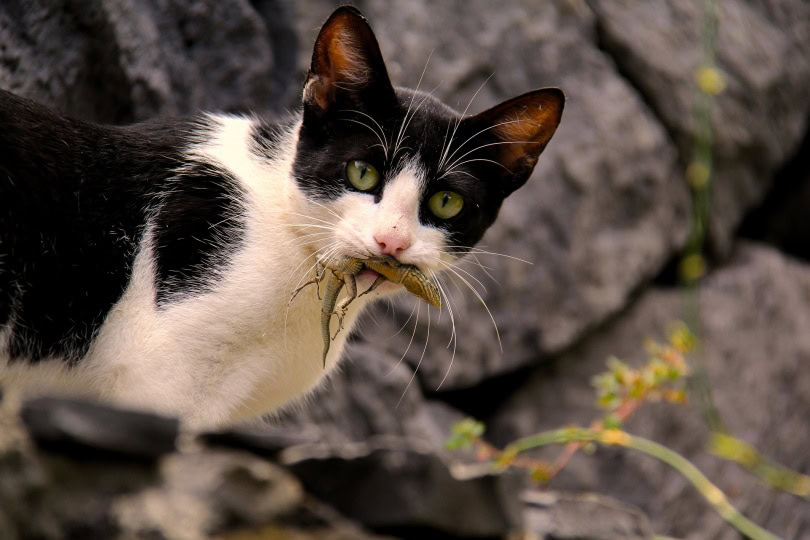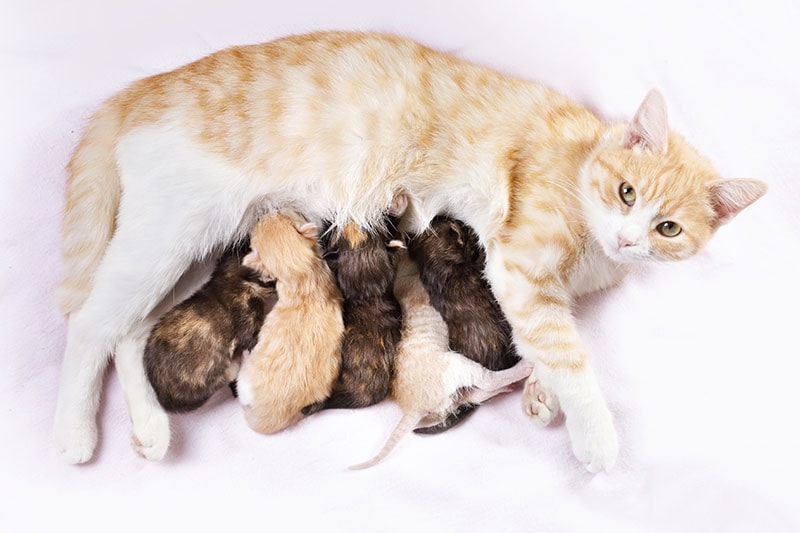VET APPROVED

The information is current and up-to-date in accordance with the latest veterinarian research.
Learn more »Click to Skip Ahead
There are an estimated 60 million to 100 million feral and abandoned cats in the US.1 Trap, neuter, and return (TNR) programs were developed as a way to try to reduce feral cat populations humanely. A popular TNR program that began in 1992 reported positive results that encouraged the funding and execution of similar programs.2
However, as more data has been collected and analyzed in recent years, the results show that TNR programs may not always be effective in lowering the number of feral cats, due to many factors. That said, organizations and experts in the field have differing opinions on TNR programs and their efficacy. Having a proper understanding of these programs may help people find the most effective and humane way to address feral cat populations.

Please note that this article is meant to educate and raise awareness of the feral cat problem worldwide and does not express the personal opinions of the author or the veterinarian. The research has been critically reviewed and presented to the readers for their edification.
How Do TNR Programs Work?
TNR programs essentially catch feral cats and either spay or neuter them before releasing them back outdoors. You can find several organizations that implement TNR programs, and each has its own methods. However, most follow a similar process.
First, the staff will set out humane traps for feral and stray cats. The most common trap that’s used is a wire box trap. Once a cat is captured, they’ll be taken to a veterinary clinic or a spay-and-neuter clinic. A veterinarian will then perform the surgery on the cat. Some programs will also vaccinate the cat to prevent and minimize the spread of rabies and other contagious feline diseases.
Once the cat is spayed or neutered, they’ll stay in a designated carrier or kennel until they have recovered from the surgery. Once they receive a health clearance, they’ll be returned to the area where they were initially found. Most cats that have been captured by TNR programs will also be ear-tipped to mark that they’ve already been spayed or neutered.

How Are TNR Programs Implemented?
Many humane societies, animal shelters, and wildlife control agencies have their own TNR programs. There’s usually a main coordinator who runs them. They’ll usually manage people who trap and transport the feral cats to spay-and-neuter facilities and appoint people to track data. They’ll also coordinate with the participating facilities that perform spay and neuter procedures.
Some programs use volunteers to trap feral cats and provide basic post-surgery care. Some veterinarians and veterinary clinics will partner with TNR programs to provide free or low-cost spay and neuter surgeries. Program coordinators will have to make sure to come up with a care plan for cats to ensure they have a safe place to stay while they recover from the anesthetic and the surgery.
Since TNR programs are meant to reduce feral cat populations, it’s important to have data collectors who keep track of several different factors. They often have to monitor the total number of feral cat populations, the number of cats that go through the TNR program, and the prevalence of rabies and other infectious diseases in feral cat colonies.
Most TNR programs receive public funding, grants, and donations, so a grant writer may be employed to ensure that the program continues to receive funds to operate.
Where Is It Used?
You can find many animal rescues and wildlife control agencies across the U.S. participating in a TNR program. Major cities, like New York City, Los Angeles, and Chicago, have multiple agencies that use these programs.
TNR programs are becoming more widely used and have a generally positive public opinion. However, recent research papers are questioning whether they’re actually the most humane and effective means of controlling feral cat numbers. Another concern is the impact that feral and stray cats, along with outdoor cats with owners, have on wildlife, as felines have contributed to the extinction of 63 species of birds, small mammals, and reptiles.3
There’s data that has revealed that TNR programs in themselves don’t have a significant enough impact on reducing feral cat populations. This may be due to the continuous immigration of entirely new cats into the colonies, inconsistency in conducting the programs, inability to catch all the cats from a particular colony, and lack of extensive follow-up. Additional factors must be present for TNR programs to address feral cat populations effectively. For example, one study found that areas with higher adoption rates and neutered cat rates and lower rates of new cats immigrating to cat colonies work best with TNR programs.
So, while many cities implement TNR programs, these would be more effective in places that have additional conditions that slow down or prevent the growth of feral cat colonies, such as education of the public, neutering, responsible pet ownership, and adoption and other means of getting cats off the streets. However, not all states or countries support TNR programs. In fact, in some jurisdictions, they may be banned or otherwise lack support. Australia is one example.

Potential Advantages of TNR Programs
TNR programs may have several advantages. First, by neutering individual cats and preventing them from reproducing, there is a reduction in the overall number of feral kittens, with improved quality of life for those cats that participated in the program. Second, some TNR facilities may provide vaccinations for cats that wouldn’t be able to get them otherwise. However, this may not always be effective, as the cats may already be carrying certain viral or bacterial diseases at the time of their vaccination, and they are highly unlikely to ever receive a booster injection unless they get adopted. Still, many programs will at least vaccinate captured cats to minimize the spread of rabies.
Third, captured cats are assessed to see if they can be socialized or are capable of being adopted or rehomed. This enables some cats to escape dangerous outdoor life and find safe homes and enjoy life as indoor cats.
Lastly, many TNR programs gather important data on feral cats in the area. Along with documenting population numbers, they can gather data on the types of infectious diseases and parasites that are most prevalent in the cat colonies. They can also pinpoint areas that have the highest and lowest numbers of feral cats.
Potential Disadvantages of TNR Programs
Critics of TNR programs are often skeptical about how humane they are. Feral cats have significantly shorter life expectancies than indoor cats because they’re more prone to dangerous accidents and contracting fatal diseases. Releasing feral cats back outdoors may not be the safest option for them, so it may be more helpful and humane to concentrate efforts on providing safer living spaces for feral cats.
More recent reviews and scientific studies also show that TNR programs aren’t necessarily that effective in reducing feral cat populations in the long run. While they may be an effective short-term solution in theory, they don’t really account for the continuous stream of new feral cats immigrating to a cat colony.


Frequently Asked Questions (FAQ)
What are the differences between TNR and RTF programs?
Return-to-field (RTF) is part of TNR programs. RTF programs are usually implemented by animal shelters and no-kill animal welfare organizations for cats that can’t be adopted. This is typically because the shelters are overpopulated, leaving no other option than euthanasia or release. These organizations may take in homeless cats, spay or neuter them, vaccinate them, and return them to where they were found.
TNR programs operate more specifically for feral cats. They’re usually implemented by smaller cat rescue groups and usually involve a caregiver or coordinator who tracks the progress of their designated feral cat colony. These caregivers can help ensure that the surrounding area of the cat colony is safer for feral cats.
How long do TNR programs keep cats after they’ve been neutered or spayed?
Most cats can recover from neuter or spay surgeries within 24 to 48 hours. The condition of feral cats is monitored, and some cats will stay in a facility for longer if they require more recovery time.
Do spaying and neutering affect feral cat behavior?
Spay and neutering may affect a feral cat’s behavior by reducing aggression, particularly during mating season. Males may be less likely to engage in fights over territory. Feral cats that have been spayed or neutered may also have a reduced tendency to roam because they won’t need to find a mate.
However, just because a feral cat gets spayed or neutered doesn’t mean that they’re socialized. They still may not be friendly toward people, and it may not be possible for them to become adoptable.

New Research Surrounding the Efficacy and Long-Term Outcomes of TNR Programs
The efficacy and implementation of TNR programs have started to gain more interest in recent years after the extensive collection of data and monitoring of feral cat populations. Ethical and welfare challenges have been identified in a paper published in Australia, including the quality of life for stray cats after being released back on the street; the stress of the TNR experience for the cats; their vulnerability to injury, parasites, and disease due to the lack of medical attention; their diet and effects of their hunting; and the impact on people, pet cats, and wildlife. The researchers suggest that adoption, early neutering, community education initiatives, responsible pet ownership, vigorous trap-and-removal programs, and identification and confinement laws are the only ways to truly improve the quality of life for these cats, to minimize euthanasia, and to protect wildlife, pet cats, and human health.

A primary challenge that reduces the success of TNR programs is the continuous introduction of unsterilized cats into the colonies. This makes it difficult to control feral cat populations, and their numbers often tend to rise with time. Responsible pet ownership, rabies vaccinations, and the removal of strays through adoption and sanctuaries remain integral components of controlling rabies and other diseases.
Research has also focused on the ecological threat to native species, with cats being a potential reservoir of animal and human diseases. The only way to minimize these effects is by removing the cats from the environment.
Finally, the Committee on Environmental Issues has expressed concerns regarding the potential legal liability for veterinarians and other professionals who participate in TNR programs due to potential violations of the Endangered Species Act or Migratory Bird Treaty Act.
All of this has started a discussion on other humane ways to manage feral feline populations. Hopefully, the future will bring more solutions and ideas regarding the protection of cats, along with other wildlife and all animal and human health.

Conclusion
TNR programs are popular methods used to control feral cat colonies. Humans capture, neuter or spay, vaccinate, and release feral cats back to their outdoor established areas. Mixed responses and variable successes of TNR programs have been observed over the past few years, with several challenges and concerns. Some people believe they’re the most humane way to care for feral cat colonies, while other researchers have done studies and collected data that show that TNR programs aren’t always that effective.
One thing that’s clear is that dealing with feral cat colonies is an incredibly complex issue. So, it’s important to monitor the progress of TNR programs and make adjustments to find the most humane and effective way to address feral cat population problems.
- Rabies prevention and management of cats in the context of trap-neuter-vaccinate-release programmes
- An Examination of an Iconic Trap-Neuter-Return Program: The Newburyport, Massachusetts Case Study – PMC
- WEC423/UW468: How Effective and Humane Is Trap-Neuter-Release (TNR) for Feral Cats?
- Professional, ethical, and legal dilemmas of trap-neuter-release
- What to do with feral cats: Examining TNR for population management
- Feral Cats | PETA
- The welfare of feral cats and wildlife
- An Examination of an Iconic Trap-Neuter-Return Program: The Newburyport, Massachusetts Case Study – PMC
- Feral Cat Laws by State 2024
- ACT the only Australian jurisdiction where cat management program trap, neuter, return is legal – ABC News
- Cats and Birds | American Bird Conservancy
- Reply to Crawford et al.: Why Trap-Neuter-Return (TNR) Is an Ethical Solution for Stray Cat Management – PMC
- A Case of Letting the Cat out of The Bag-Why Trap-Neuter-Return Is Not an Ethical Solution for Stray Cat (Felis catus) Management
- Outcome: Return to field | International Cat Care
Featured Image Credit: Dimitris Vetsikas, Pixabay











